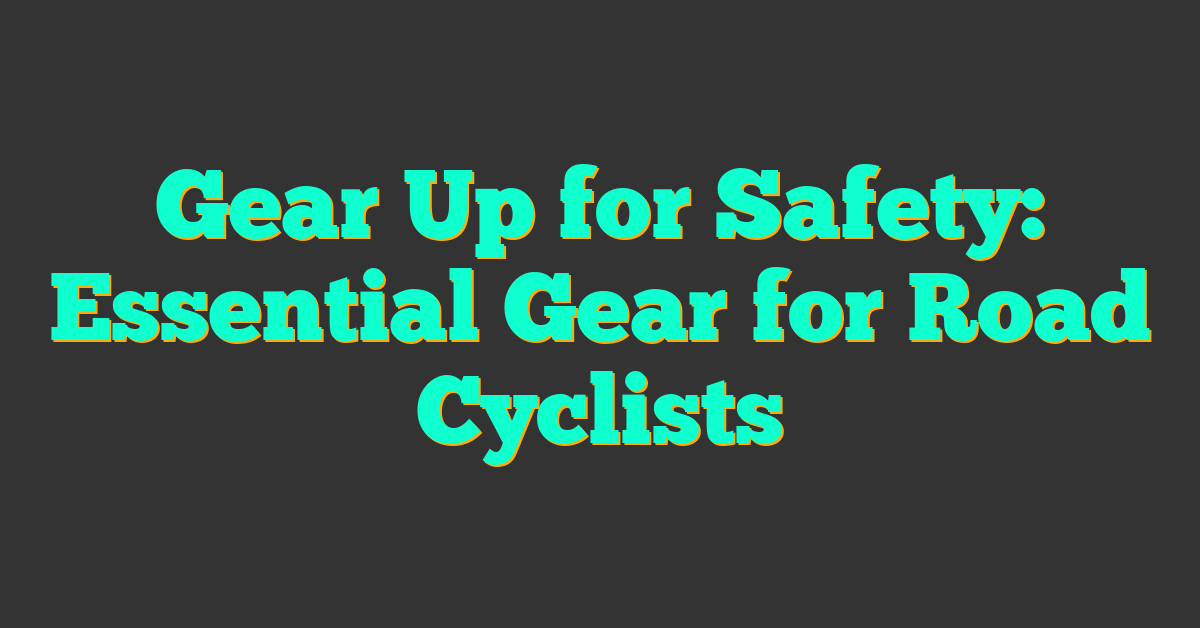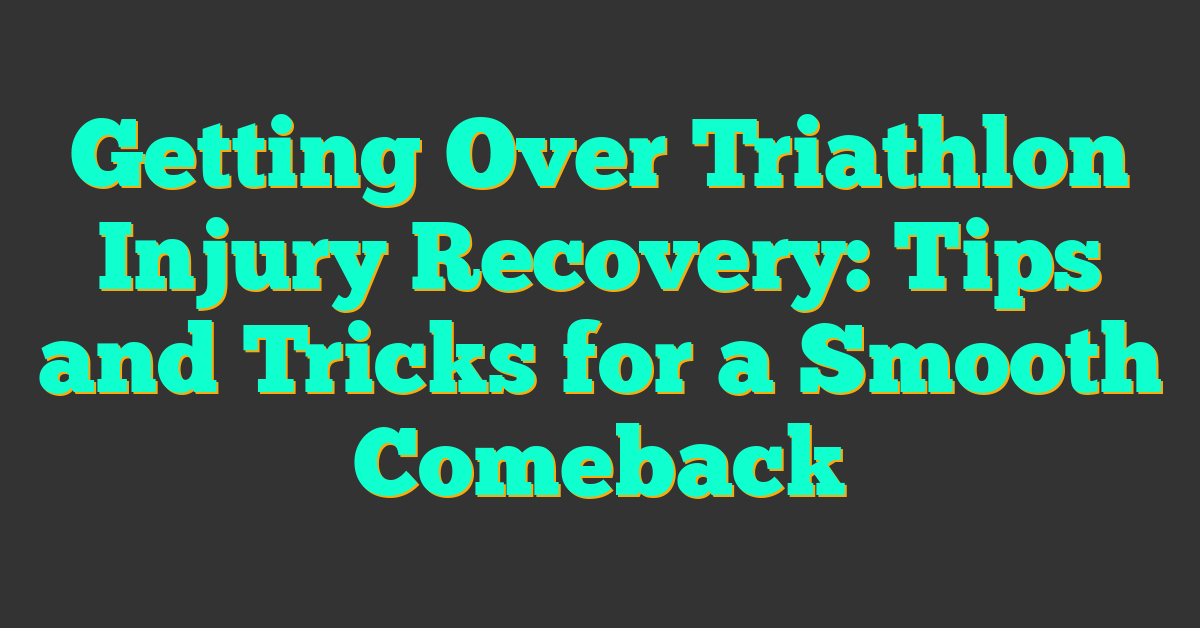As a road cyclist, staying safe while riding is paramount. With over 130,000 cycling injuries each year, it’s important to take the necessary precautions to protect yourself while cycling. Fortunately, there is a wide range of gear available that can help keep you safe on the road.

Essential safety gear for cyclists includes a helmet, lights, and reflective clothing. A helmet is your first line of defense in the event of a fall or collision. Lights can help increase your visibility, especially when riding at night or in low-light conditions. Reflective clothing can also help increase your visibility to motorists and other cyclists on the road.
Navigating traffic safely is also crucial for road cyclists. This includes following traffic laws and using hand signals to communicate with motorists. Additionally, maintaining your bike and being prepared for on-road repairs can help prevent accidents and keep you safe while riding. By taking these precautions and using the right gear, you can enjoy a safe and enjoyable cycling experience.
Key Takeaways
- Essential safety gear for cyclists includes a helmet, lights, and reflective clothing.
- Navigating traffic safely includes following traffic laws and using hand signals to communicate with motorists.
- Maintaining your bike and being prepared for on-road repairs can help prevent accidents and keep you safe while riding.
Essential Safety Gear for Cyclists
https://www.youtube.com/watch?v=dynnKiX667U&embed=true

As a cyclist, your safety should be your top priority. Equipping yourself with the right safety gear is paramount to protect yourself and enhance visibility, ensuring a secure and enjoyable riding experience. In this section, we’ll explore the essential safety gear for cyclists.
Helmets and Head Protection
Wearing a helmet is one of the most basic and essential pieces of gear for any cyclist. It provides protection for your head in the event of a fall or collision, reducing the risk of serious head injuries. Make sure to choose a helmet that fits well and has adjustable straps to ensure a secure fit. The padding inside the helmet should also be comfortable and snug.
Visibility and Lighting
Being visible to motorists is critical to your safety as a cyclist, especially when riding at night or in low-light conditions. High-visibility clothing, reflectors, and ankle bands can help you stand out on the road. Installing daytime running lights on your bike can also enhance your visibility during the day. Make sure to check your state’s laws regarding lighting requirements for cycling.
Protective Clothing and Accessories
In addition to a helmet, wearing protective clothing and accessories can help prevent injuries in case of a fall. Cycling gloves can provide padding and protect your hands in the event of a crash. High-visibility clothing can also help you stand out on the road, while padded cycling shorts can provide comfort during long rides.
Overall, investing in the right cycling safety gear can make a significant difference in your safety and enjoyment of cycling. Make sure to choose gear that fits well and is comfortable to wear. Stay safe and happy cycling!
Navigating Traffic Safely
https://www.youtube.com/watch?v=j8zkpZVmyww&embed=true
As a road cyclist, navigating traffic safely is crucial to ensure your own safety and the safety of other road users. Here are some tips to help you navigate traffic safely:
Understanding Traffic Laws
It’s important to understand the traffic laws in your area. This will help you to know your rights and responsibilities as a cyclist on the road. For example, in most states, cyclists are required to ride as close as practicable to the right-hand curb or edge of the roadway. However, there are exceptions to this rule, such as when passing another vehicle or when preparing for a left turn.
Hand Signals and Communication
Hand signals are an effective way to communicate with other road users. Use your left arm to signal when you are turning left or right, and use your right arm to signal when you are stopping or slowing down. In addition to hand signals, you can also use a bell or horn to alert other road users of your presence.
Intersections and Junctions
Intersections and junctions can be dangerous for cyclists, especially if other road users are not aware of your presence. To navigate these areas safely, it’s important to be visible and communicate your intentions clearly. Use hand signals to indicate your intended direction of travel, and make sure to make eye contact with other road users to ensure they have seen you.
Remember to always be aware of your surroundings and anticipate potential hazards. Check blind spots and be cautious of vehicles merging or turning. By following these tips and practicing good road safety, you can enjoy a safe and enjoyable cycling experience on the road.
Bike Maintenance and On-Road Repairs
https://www.youtube.com/watch?v=Iuy7wwMm6HY&embed=true
As a road cyclist, it’s essential to keep your bike in good condition to ensure your safety while riding. Regular bike check-ups and carrying an essential repair kit can help you avoid breakdowns and accidents on the road.
Regular Bike Check-Ups
Before hitting the road, make sure to perform a quick check-up on your bike. Check your brakes to ensure they are functioning correctly. If your brakes are worn out, replace them immediately. Also, check your tires for any signs of wear or punctures. Make sure they are inflated to the recommended pressure level.
It’s also crucial to check your bike lights before riding, especially if you plan to ride at night. A headlight and taillight are essential for visibility and safety. Make sure they are working correctly and have fresh batteries.
Essential Repair Kit Contents
Carrying an essential repair kit can help you fix minor issues on the road and avoid being stranded. Here are some items you should include in your repair kit:
- A hand pump or CO2 inflator to inflate your tires in case of a flat
- Tire levers to remove and replace tires
- Spare tubes or patch kits to fix punctured tires
- Multi-tool to make minor adjustments and repairs
- Chain lube to keep your chain running smoothly
By carrying these items, you can quickly fix minor issues on the road and avoid being stranded. Remember to replace any used or expired items in your repair kit regularly.
Overall, regular bike check-ups and carrying an essential repair kit can help you stay safe while road cycling. By taking care of your bike and being prepared for minor repairs, you can enjoy a smooth and safe ride.
Staying Hydrated and Energized
« Gear Up for Your First Triathlon: Essential Equipment for Beginners
https://www.youtube.com/watch?v=eoz1PDB5WLM&embed=true
As a road cyclist, it’s crucial to stay hydrated and energized during your rides. Dehydration can lead to fatigue, muscle cramps, and even heat exhaustion. That’s why it’s important to bring a water bottle with you on every ride. You can attach a water bottle cage to your bike frame to keep it secure while you ride.
But simply drinking water may not be enough to keep you hydrated during intense exercise. That’s where hydration packs come in. These backpacks have a water reservoir and a drinking tube that allows you to sip water while you ride. They’re especially useful for longer rides or rides in hot weather.
In addition to staying hydrated, it’s important to fuel your body with the right nutrients. Eating a balanced meal before your ride can give you the energy you need to power through your ride. During your ride, you can pack some snacks or energy bars to keep your energy levels up. Choose snacks that provide a good balance of carbohydrates, protein, and healthy fats.
Staying hydrated and energized can also have long-term health benefits. According to the American Cancer Society, regular exercise and a healthy diet can help reduce the risk of cancer. So, by taking care of your body during your rides, you’re not only improving your performance but also your overall health.
Security and Emergency Preparedness
https://www.youtube.com/watch?v=XV6NCX4CR8k&embed=true
As a road cyclist, it’s important to take measures to protect yourself and your bike from theft and be prepared for emergencies. Here are some tips on how to do so:
Preventing Theft with Bike Locks
One of the most important things you can do to prevent bike theft is to invest in a high-quality bike lock. Look for a lock that is made of durable materials such as hardened steel, and choose a lock that is appropriate for the level of theft risk in your area. For example, if you live in a high-theft area, you may want to invest in a heavy-duty U-lock or chain lock.
When locking up your bike, make sure to secure it to a fixed object such as a bike rack or post. Avoid locking your bike to anything that can be easily cut or removed, such as a tree or fence. Also, try to lock your bike in a well-lit area, as thieves are less likely to attempt theft in a visible location.
Emergency Contact and Road ID
In case of an emergency, it’s important to have your emergency contact information readily available. One way to do this is to wear a Road ID bracelet or tag, which contains your name, emergency contact information, and any important medical information. This can help first responders quickly identify you and notify your loved ones in case of an emergency.
It’s also a good idea to carry a cell phone with you while cycling, so you can call for help if needed. Make sure your phone is fully charged before heading out, and consider carrying a portable charger in case your battery runs low.
In addition to emergency contact information, it’s also a good idea to carry basic first aid supplies such as bandages, antiseptic wipes, and pain relievers. These can come in handy in case of minor injuries while cycling.
By taking these simple steps, you can help ensure your safety and preparedness while cycling on the road.
Frequently Asked Questions

What essential safety equipment should every cyclist have?
As a cyclist, your safety should always be a top priority. The essential safety equipment every cyclist should have includes a properly fitting helmet, front and rear lights, reflective gear, and a bell or horn.
How can cyclists increase visibility for safety on the road?
To increase visibility while cycling, wear bright and reflective clothing, use lights, and attach reflective gear to your bike. It’s also important to avoid riding in blind spots of cars and trucks, and to make eye contact with drivers before crossing intersections.
What are the top safety gear items for kids who ride bikes?
For kids who ride bikes, the top safety gear items include a properly fitting helmet, reflective clothing, front and rear lights, and a bell or horn. Training wheels or balance bikes can also help young children learn to ride safely.
What should I wear to protect myself while cycling?
To protect yourself while cycling, wear a properly fitting helmet, bright and reflective clothing, and gloves to protect your hands in case of a fall. Consider wearing padded shorts and a cycling jersey for added comfort and protection.
Where can I find a reputable bike safety gear shop?
You can find a reputable bike safety gear shop by asking for recommendations from other cyclists, checking online reviews, or visiting your local bike shop. Look for a shop with knowledgeable staff who can help you find the right gear for your needs and budget.
What protective gear is recommended for motorcycle riders?
For motorcycle riders, the recommended protective gear includes a DOT-approved helmet, a leather or armored jacket, gloves, boots, and riding pants. Consider wearing additional protective gear such as a back protector or chest protector for added safety.





![Lamicall Bike Frame Bag Waterproof - [1s Release] [2 in](https://m.media-amazon.com/images/I/41WyOmmNsYL._SL500_.jpg)




